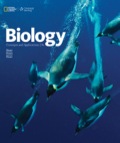
Concept explainers
Which is not a
| a. adenine | c. glutamine | e. cytosine |
| b. guanine | d. thymine | f. All are in DNA. |
Introduction:
DNA is a polymer of nucleotides. Each nucleotide consists of a deoxyribose sugar, three phosphate groups, and a nitrogen-containing base.
Answer to Problem 1SQ
Correct answer:
Glutamine is not a nucleotide base in DNA. Hence, the correct answer is option c.
Explanation of Solution
Reason for correct answer:
Option c. is given as “glutamine.”
The four nitrogen bases of DNA are adenine, thymine, cytosine, and guanine. Glutamine is one of the
Reason for incorrect answer:
Option a. is given as, “adenine.”
Adenine is one of the two purine bases that form the nucleotides of DNA. Glutamine is classified under the category of amino acids. Hence, option a. is incorrect.
Option b. is given as, “guanine.”
Guanine is a nitrogenous base that belongs to the purine group. Glutamine is absent in the double-stranded DNA structure. Hence, option b. is incorrect.
Option d. is given as, “thymine.”
Thymine belongs to the pyrimidine group of nitrogen bases of DNA. Glutamine does not belong to the category of pyrimidines. Hence, option d. is incorrect.
Option e. is given as, “cytosine.”
Cytosine is a pyrimidine base in the nucleotides of DNA. Glutamine does not belong to the category of either purines or pyrimidines. Hence, option e. is incorrect.
Option f. is given as, “All are in DNA.”
Adenine, thymine, cytosine, and guanine are the four nitrogenous bases present in the double-helical structure of DNA. However, glutamine does not belong to the category of nitrogenous bases present in the DNA molecule. Hence, option f. is incorrect.
Hence, the options a., b., d., e., and f. are incorrect.
The four nitrogen bases of DNA are adenine, thymine, cytosine, and guanine. Glutamine is an amino acid and is absent in DNA bases. Thus, the correct answer is option c.
Want to see more full solutions like this?
Chapter 8 Solutions
EBK BIOLOGY: CONCEPTS AND APPLICATIONS
- CUÁ Glycine A C C Newly formed molecule Glycine Arginine Proline Alanine A C C CC G GGAUUGGUGGGGC Structure X I mRNAarrow_forwardAdaptations to a Changing Environment Why is it necessary for organisms to have the ability to adapt? Why is the current environment making it difficult for organisms like the monarch butterfly to adapt? Explain how organisms develop adaptations.arrow_forwardArtificial Selection: Explain how artificial selection is like natural selection and whether the experimental procedure shown in the video could be used to alter other traits. Why are quail eggs useful for this experiment on selection?arrow_forward
- Don't give AI generated solution otherwise I will give you downwardarrow_forwardHello, Can tou please help me to develope the next topic (in a esquematic format) please?: Function and Benefits of Compound Microscopes Thank you in advance!arrow_forwardIdentify the AMA CPT assistant that you have chosen. Explain your interpretation of the AMA CPT assistant. Explain how this AMA CPT assistant will help you in the future.arrow_forward
- Fitness 6. The primary theory to explain the evolution of cooperation among relatives is Kin Selection. The graph below shows how Kin Selection theory can be used to explain cooperative displays in male wild turkeys. B When paired, subordinant males increase the reproductive success of their solo, dominant brothers. 0.9 C 0 Dominant Solo EVOLUTION Se, Box 13.2 © 2023 Oxford University Press rB rB-C Direct Indirect Fitness fitness fitness gain Subordinate 19 Fitness After A. H. Krakauer. 2005. Nature 434: 69-72 r = 0.42 Subordinant Dominant a) Use Hamilton's Rule to show how Kin Selection can support the evolution of cooperation in this system. Show the math. (4 b) Assume that the average relatedness among male turkeys in displaying pairs was instead r = 0.10. Could kin selection still explain the cooperative display behavior (show math)? In this case, what alternative explanation could you give for the behavior? (4 pts) 7. In vampire bats (pictured below), group members that have fed…arrow_forwardExamine the following mechanism and classify the role of each labeled species in the table below. Check all the boxes that applyarrow_forward1. Define and explain the two primary evolutionary consequences of interspecific competitionarrow_forward
